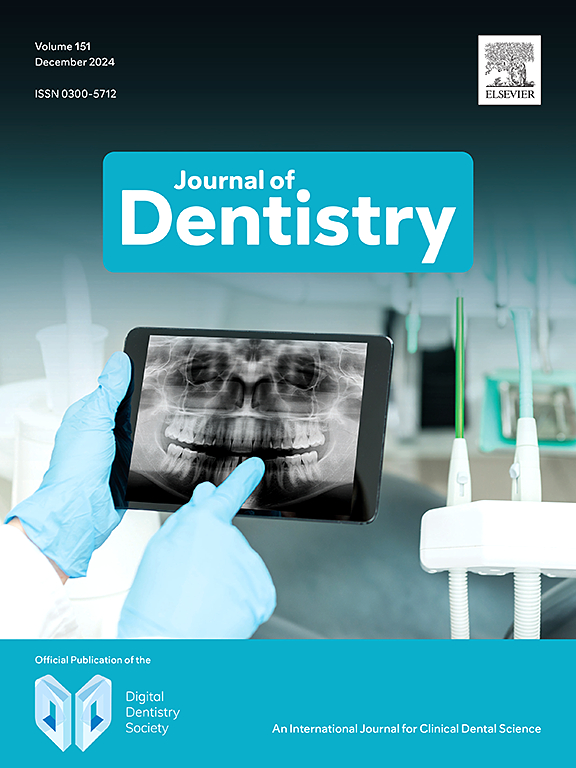澳大利亚牙髓医生和其他牙科医生对冠状面修复的孔道屏障偏好:一项问卷调查。
IF 4.8
2区 医学
Q1 DENTISTRY, ORAL SURGERY & MEDICINE
引用次数: 0
摘要
目的:比较专科牙髓医生(SEP)和普通及其他专科医生(GDP+)在补根牙(RFT)中使用孔口屏障(OB)的情况,并确定常用材料、选择原因和技术。方法:采用在线调查的方法,对澳大利亚的SEP和GDP+执业进行调查。要求有关材料选择和技术选择的人口统计和多项选择问题来评价使用模式并将其与实践和培训背景联系起来。采用Fisher精确检验来比较不同从业者群体的分类变量。结果:有457例符合条件的应答:393例(86%)GDP+, 64例(14%)SEP。在429例报告髓内治疗或修复牙齿的患者中,317例(73.9%)选择OB;大多数人(91.8%)偏爱2mm的补根深度,SEP比GDP+更偏爱2mm (p= 0.02)。OB的首选材料是常规和树脂改性GIC (GIC)、树脂复合材料(RC)、CavitTM和聚羧酸锌水泥(ZPC)。“易于使用”是所有GIC和RC从业者的共同原因。SEP(pTM)对“密封能力”的选择明显多于SEP(pTM)。结论:澳大利亚牙科医生广泛放置OB,选择的材料很少,最常见的是便于使用或密封能力。本研究的结果表明,应该进行进一步的研究,以调查这些材料作为OB的相对性能,并告知临床医生在恢复RFT时的选择。本文章由计算机程序翻译,如有差异,请以英文原文为准。
Orifice barrier preferences for coronal restoration of root filled teeth by endodontists and other dental practitioners in Australia: A questionnaire survey
Objectives
To compare the use of orifice barriers (OB) in root-filled teeth (RFT) between specialist endodontic practitioners (SEP) and general and other specialist practitioners (GDP+), and identify common materials, reasons for selection, and techniques.
Methods
An online survey was distributed to SEP and GDP+ practising in Australia. Demographic and multiple-choice questions relating to material selection and technique choices were asked to evaluate and relate usage patterns to practising and training backgrounds. Fisher's exact tests were undertaken to compare categorical variables across practitioner groups. Significance level was set at p<.05.
Results
There were 457 eligible responses: 393(86%) GDP+ and 64(14%) SEP. Of 429 reporting endodontically treating or restoring teeth, 317(73.9%) placed OB; preferred depth of root filling removal by most (91.8%) was ≤ 2 mm, with more SEP preferring 2 mm than GDP+(p=.02). Preferred materials for OB were conventional and resin-modified GIC (GIC), resin composite materials (RC), Cavit™ and zinc polycarboxylate cement (ZPC). ‘Ease of use’ was a common reason among all practitioners for GIC and RC. Significantly more SEP(p<.001) chose ZPC in all teeth and more commonly because of ‘Ease of use’ for both posterior (p<.001) and anterior (p=.002) teeth. All ZPC-using SEP preferred using a paste-filler/lentulo spiral, significantly more than GDP+ for posterior (p<.001) and anterior (p=.002) teeth. Cavit™ was often chosen for ‘Sealing ability’.
Conclusions
OB were widely placed by dental practitioners in Australia, with a small group of materials selected, most commonly for ease of use or sealing ability. The findings of this study suggest that further research should be undertaken to investigate the relative performance of these materials as OB and to inform the clinician's choices when restoring RFT.
求助全文
通过发布文献求助,成功后即可免费获取论文全文。
去求助
来源期刊

Journal of dentistry
医学-牙科与口腔外科
CiteScore
7.30
自引率
11.40%
发文量
349
审稿时长
35 days
期刊介绍:
The Journal of Dentistry has an open access mirror journal The Journal of Dentistry: X, sharing the same aims and scope, editorial team, submission system and rigorous peer review.
The Journal of Dentistry is the leading international dental journal within the field of Restorative Dentistry. Placing an emphasis on publishing novel and high-quality research papers, the Journal aims to influence the practice of dentistry at clinician, research, industry and policy-maker level on an international basis.
Topics covered include the management of dental disease, periodontology, endodontology, operative dentistry, fixed and removable prosthodontics, dental biomaterials science, long-term clinical trials including epidemiology and oral health, technology transfer of new scientific instrumentation or procedures, as well as clinically relevant oral biology and translational research.
The Journal of Dentistry will publish original scientific research papers including short communications. It is also interested in publishing review articles and leaders in themed areas which will be linked to new scientific research. Conference proceedings are also welcome and expressions of interest should be communicated to the Editor.
 求助内容:
求助内容: 应助结果提醒方式:
应助结果提醒方式:


